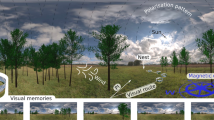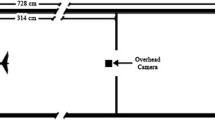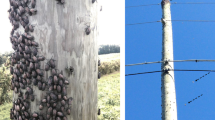Abstract
The flights of individual wasps (Vespula) were recorded as they approached a small feeder on the ground that was marked by a black cylinder ca 15 cm away. Two navigational strategies are used in these approaches. Initially, the wasp aims at the cylinder, treating it as a beacon and fixating it with frontal retina. In the last stage of the flight, the wasp assumes a preferred orientation so that the cylinder takes up a constant, more peripheral retinal position as the wasp nears the feeder. Path guidance by image-matching is likely to be limited to this final segment of the return. Wasps could gain the information needed for these distinct navigational strategies during the learning flights that they perform on their initial departures from the feeder. They fly away from the feeder in a series of arcs while turning at a mean angular velocity of 226°/s. The cylinder tends to be viewed with frontal retina during the arcs suggesting that the information required for aiming at the cylinder is acquired then. For image matching, the appearance of the cylinder needs to be learnt when the wasp is in the orientation that it adopts close to the feeder on its return flight. Wasps tend to assume this orientation during learning flights while they face the feeder. Such inspections of the feeder occur at the ends of arcs when a wasp's turning velocity is low.
Similar content being viewed by others
References
Becker L (1958) Untersuchungen über das Heimfindevermögen der Bienen. Z. Vergl Physiol 41: 1–25
Cartwright BA, Collett TS (1983) Landmark learning in bees: experiments and models. J Comp Physiol 151: 521–543
Cheng K, Collett TS, Pickhard A, Wehner R (1987) The use of visual landmarks by honeybees: Bees weight landmarks according to their distance from the goal. J Comp Physiol A 161: 469–475
Collett TS (1992) Landmark learning and guidance in insects. Phil Trans R Soc Lond B 337: 295–302
Collett TS, Baron J (1994) Biological compasses and the coordinate frame of landmark memories in honeybees. Nature 368: 137–140
Collett TS, Lehrer M (1993) Looking and learning: a spatial pattern in the orientation flight of the wasp Vespula vulgaris. Proc R Soc Lond B 252: 129–134
Krackauer DC (1995) Simple connectionist models of spatial memory in bees. J Theor Biol 172: 149–160
Lehrer M (1993) Why do bees turn back and look? J Comp Physiol A 172: 544–563
Lehrer M, Collett TS (1994) Approaching and departing bees learn different cues to the distance of a landmark. J Comp Physiol A 175: 171–177
Tinbergen N (1932) Über die Orientierung des Bienenwolfes (Philanthus triangulum Fabr.). Z Vergl Physiol 16: 305–335
Vollbehr J (1975) Zur Orientierung junger Honigbienen bei ihrem ersten Orientierungsflug. Zool Jb Allg Zool Physiol 79: 33–69
Wagner W (1907) Psychobiologische Untersuchungen an Hummeln. Zoologica 19: 1–239
Wehner R (1992) Arthropods. In: Papi F (ed) Animal homing. Chapman and Hall, London, pp 45–144
Zeil J (1993a) Orientation flights of solitary wasps (Cerceris; Sphecidae; Hymenoptera)1. Description of flight. J Comp Physiol A 172: 189–205
Zeil J (1993b) Orientation flights of solitary wasps (Cerceris; Sphecidae; Hymenoptera) 11. Similarities between orientation and return flights and the use of motion parallax. J Comp Physiol A 17: 207–222
Zeil J, Kelber A (1991) Orientation flights in ground-nesting wasps and bees share a common organisation. Verh Dtsch Zool Ges 84: 371–372
Author information
Authors and Affiliations
Rights and permissions
About this article
Cite this article
Collett, T.S. Making learning easy: the acquisition of visual information during the orientation flights of social wasps. J Comp Physiol A 177, 737–747 (1995). https://doi.org/10.1007/BF00187632
Accepted:
Issue Date:
DOI: https://doi.org/10.1007/BF00187632




